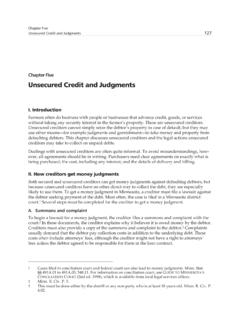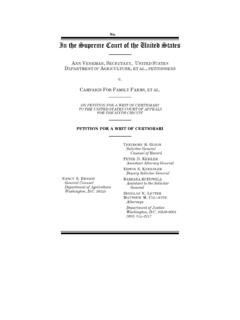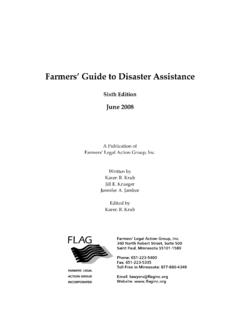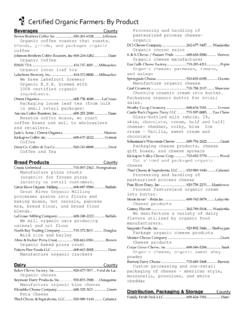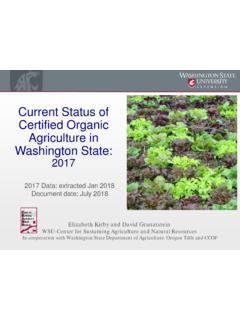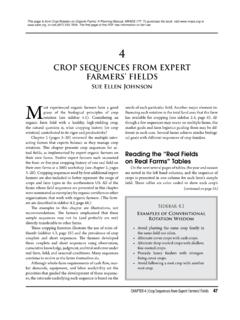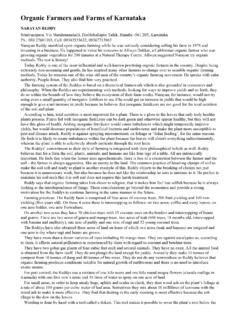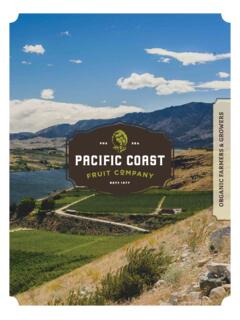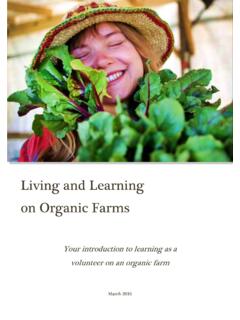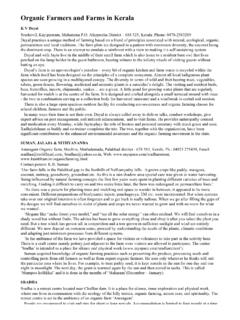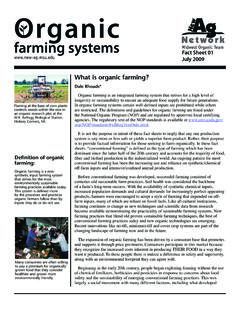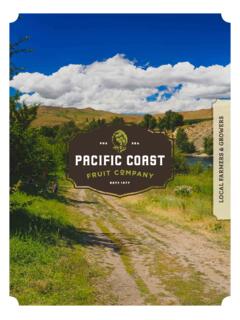Transcription of Organic Farmers in Disasters: Flooding and Whole Farm ...
1 Organic Farmers in Disasters: Flooding and Whole farm Revenue Crop Insurance January 31, 2018 Farmers Legal Action Group, Inc. Written by Stephen Carpenter Funding for this booklet was provided by: UNFI Foundation Wedge Community Co-op USDA Risk Management Agency 1 I. Introduction This booklet is intended to assist Organic Farmers in time of disaster . It looks at two important issues. First, it discusses the extremely challenging effect of a flood on an Organic farm . Second, this booklet discusses a relatively new form of crop insurance Whole - farm Revenue -- that could benefit Organic producers going forward. II. Flooding and the Organic farm A. Introduction During a flood or other natural disaster there will be a series of challenges facing every farmer.
2 For an Organic farmer, the flood or other natural disaster will have results that can be unique to Organic production. One of the merits of Organic agriculture is greater resilience in the face of a natural disaster . Soils on Organic farms, for example, seem better able to hold moisture during drought years and are more productive during extremely wet The Organic plan that Farmers adopt, and the records that Organic Farmers are required to keep, may help Farmers after a natural disaster This is especially true for the records kept along with the Successful use of disaster assistance programs often requires detailed records of crop yields and prices, of livestock harmed in the disaster or sold earlier than planned due to feed shortages, and other information. An Organic farm is likely to have the records required for disaster programs.
3 disaster assistance for Farmers sometimes comes in the form of programs created or funded by Congress long after the disaster . Well-maintained records can help Farmers document losses from previous years and establish eligibility for late-enacted programs. B. After the Flood: Some Early Steps In the early stages of flood recovery, several steps may be helpful for Organic Farmers . 1. Document the Damage Almost every form of assistance for recovery for a disaster will require documentation of the effects on the farm of the disaster . One of the first steps a farmer should take in recovering from a disaster is to document the damage to the farm . Pictures and descriptions of facilities or land damaged, animals harmed, information on crops lost and plantings prevented, and other records of what happened will be helpful down the road.
4 1 See, for example, Lotter et al, The Performance of Organic and Conventional Cropping System in an Extreme Climate Year, 18(3) AMERICAN JOURNAL OF ALTERNATIVE AGRICULTURE 146 (2003). 2 7 , Organic system plan (2017); 7 (a) (2017). 3 See National Organic Program, Instruction: Recordkeeping, NOP 2602 (July 22, 2011). 2 2. Make Important Contacts Recovery from a farm flood will be slow and hard. Among the first steps in a recovery from the flood is to contact some people about the flood. Those to contact should include the following. Organic Farmers must submit updated information to the certifying agent each An Organic farmer affected by natural disaster should immediately notify the certifying agent of any change in the farming operation that may affect the farmer s compliance with Organic In particular, Organic Farmers should notify their certifiers right away if a natural disaster leads to application of a prohibited substance to the Many Organic Farmers will have crop insurance.
5 If so, Farmers should contact that insurance provider right away. There may be important decisions and actions to take to preserve an insurance claim. The same is true for hazard, flood, or other forms of insurance. The sooner insurance companies are notified about claims that the farmer may have the better. Some Organic Farmers have significant and longstanding contacts with local USDA offices. For example, some growers will have signed up for Noninsured Crop Assistance Program (NAP). These Farmers should contact USDA about NAP benefits right away. Other Farmers will not have had much contact with USDA. These producers may still be in position to benefit from USDA disaster programs over the medium and longer term. Farmers should make sure they know about the programs that may help. The various forms of assistance possibly available from USDA -- cost-sharing, loans, livestock disaster benefits, and others can only be applied for if the producer knows about them.
6 Whether the grower has had much contact with USDA in the past or not, after a disaster strikes it makes sense for the farmer to contact USDA, let USDA know that the farm has been hit by the disaster , and explain that the farmer is interested in knowing about any program that might be able to help in the disaster recover. 4 7 (2017). 5 7 (f)(2) (2017). 6 7 (f)(1) (2017). 3 C. Organic Certification Issues 1. The Organic Plan: Changes May be Needed Every Organic producer has a detailed Organic System Plan (OSP). 7 These plans concern almost all aspects of agricultural production, recordkeeping, and management practices. Organic plans are updated every Flooding may mean that the farmer needs to change the plan at the annual review.
7 Organic regulations allow a farmer to change the plan in the middle of the year as long as the plan still meets Organic If there are changes in the operation that are not called for in the Organic plan and the changes may affect the farms compliance with Organic regulations -- the farmer must notify the Organic certifier. 10 The certifier must agree to changes in the plan. Similarly, if the farmer adds acres or a new facility to the operation, this must be reported to the certifier. Organic rules are written to suggest that even changes that seem small need to be reported. As the rules say, any changes that may affect compliance with the regulations should be reported to the The farmer can report changes to the certifier either verbally or in It is probably wise, however, for the farmer to do both.
8 2. Report Prohibited Substances If a prohibited substance is applied to the Organic cropland, the farmer must report this to the This is true even if the application of the prohibited substance was an accident. 3. Temporary Variances A natural disaster , such as a flood, may make some parts of the Organic program impossible to maintain. USDA s Agricultural Marketing Service (AMS) is allowed to grant temporary variances from some Organic rules during a flood or other 7 7 (2017). Plans are described in detail in National Organic Program, Instruction: Organic System Plans, Organic System Plan Updates, and Notification of Changes , NOP 2615 (December 16, 2013). 8 7 (2017); National Organic Program, Instruction: Organic System Plans, Organic System Plan Updates, and Notification of Changes , NOP 2615, section (December 16, 2013).
9 9 7 (b) (2017); National Organic Program, Instruction: Organic System Plans, Organic System Plan Updates, and Notification of Changes , NOP 2615, section (December 16, 2013). 10 National Organic Program, Instruction: Organic System Plans, Organic System Plan Updates, and Notification of Changes , NOP 2615, section (December 16, 2013). 11 National Organic Program, Instruction: Organic System Plans, Organic System Plan Updates, and Notification of Changes , NOP 2615, section (December 16, 2013). 12 National Organic Program, Instruction: Organic System Plans, Organic System Plan Updates, and Notification of Changes , NOP 2615, section (December 16, 2013). 13 National Organic Program, Instruction: Organic System Plans, Organic System Plan Updates, and Notification of Changes , NOP 2615, section (December 16, 2013).
10 4 natural disaster . AMS is allowed to grant what are called temporary variances from some Organic rules when there is a natural disaster declared by AMS may also do so for an undeclared disaster if there is damage caused by drought, wind, flood, excessive moisture, hail, tornado, earthquake, fire, or other business interruption. AMS grants temporary variances with some regularity and natural disasters especially droughts have been a common trigger for the At times AMS has approved a waiver for broad areas. One variance in 2011, for example, applied to the entire state of Texas. In 2012, AMS granted a variance relating to dry matter pasture requirements for hundreds of counties. a. Possible Temporary Variance The following areas of Organic requirements CAN be changed in a temporary Organic rules set out the tillage and cultivation practices that may be In general, these rules improve the condition of the soil and prevent erosion, require use of cover crops and rotations, and farming in way that does not contribute to the contamination of crops soil or water by residues of prohibited substances.
